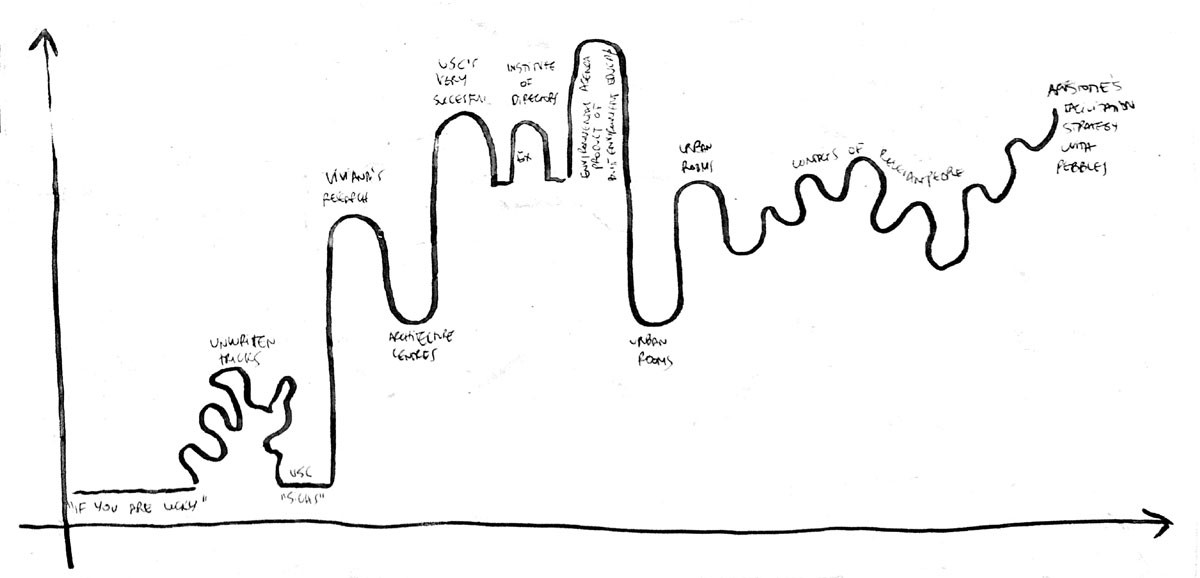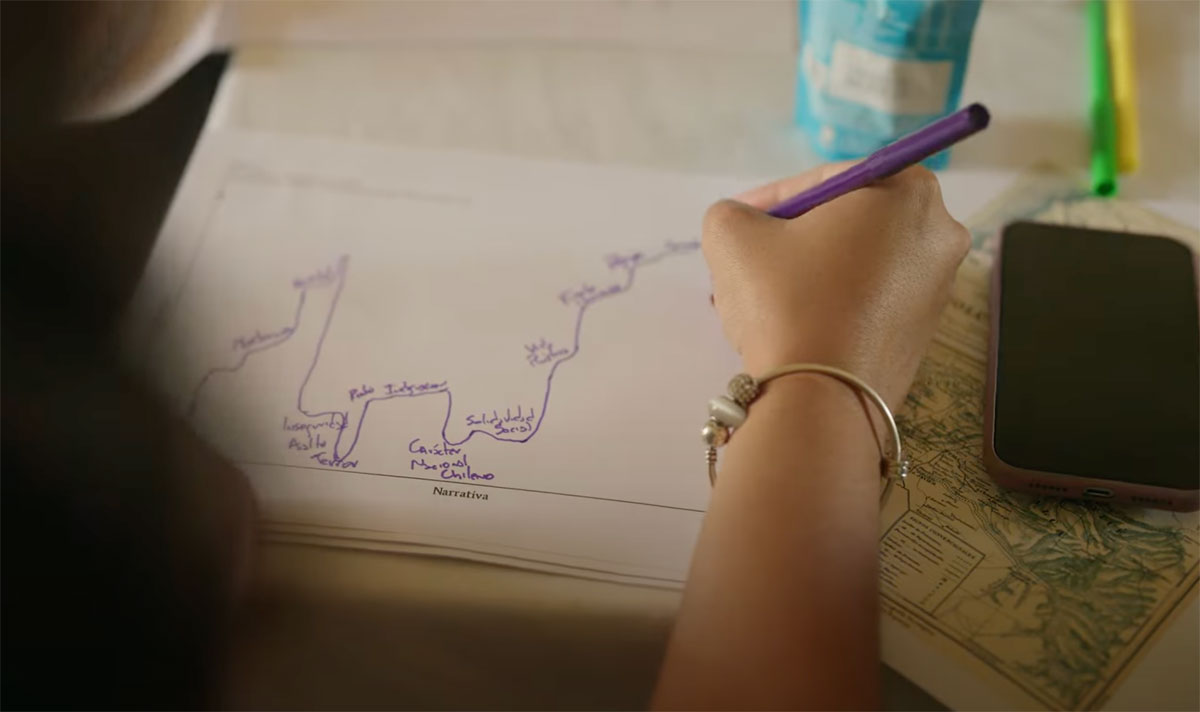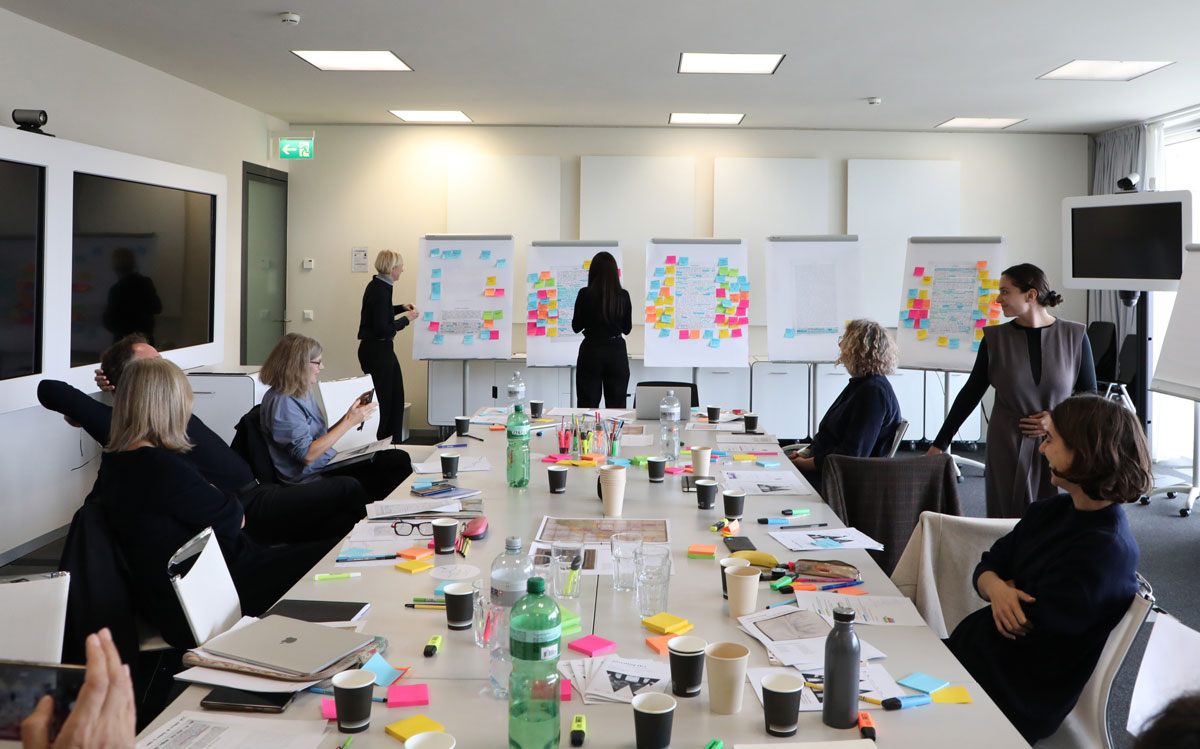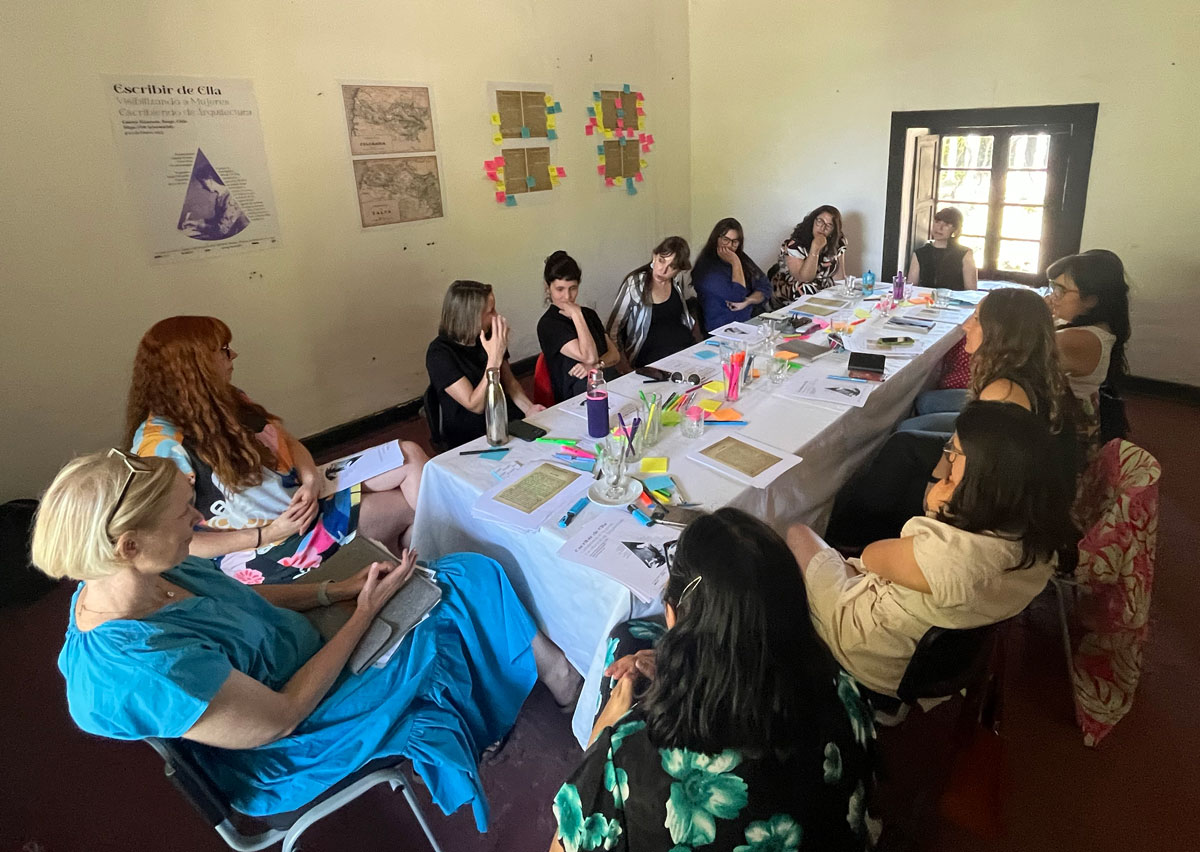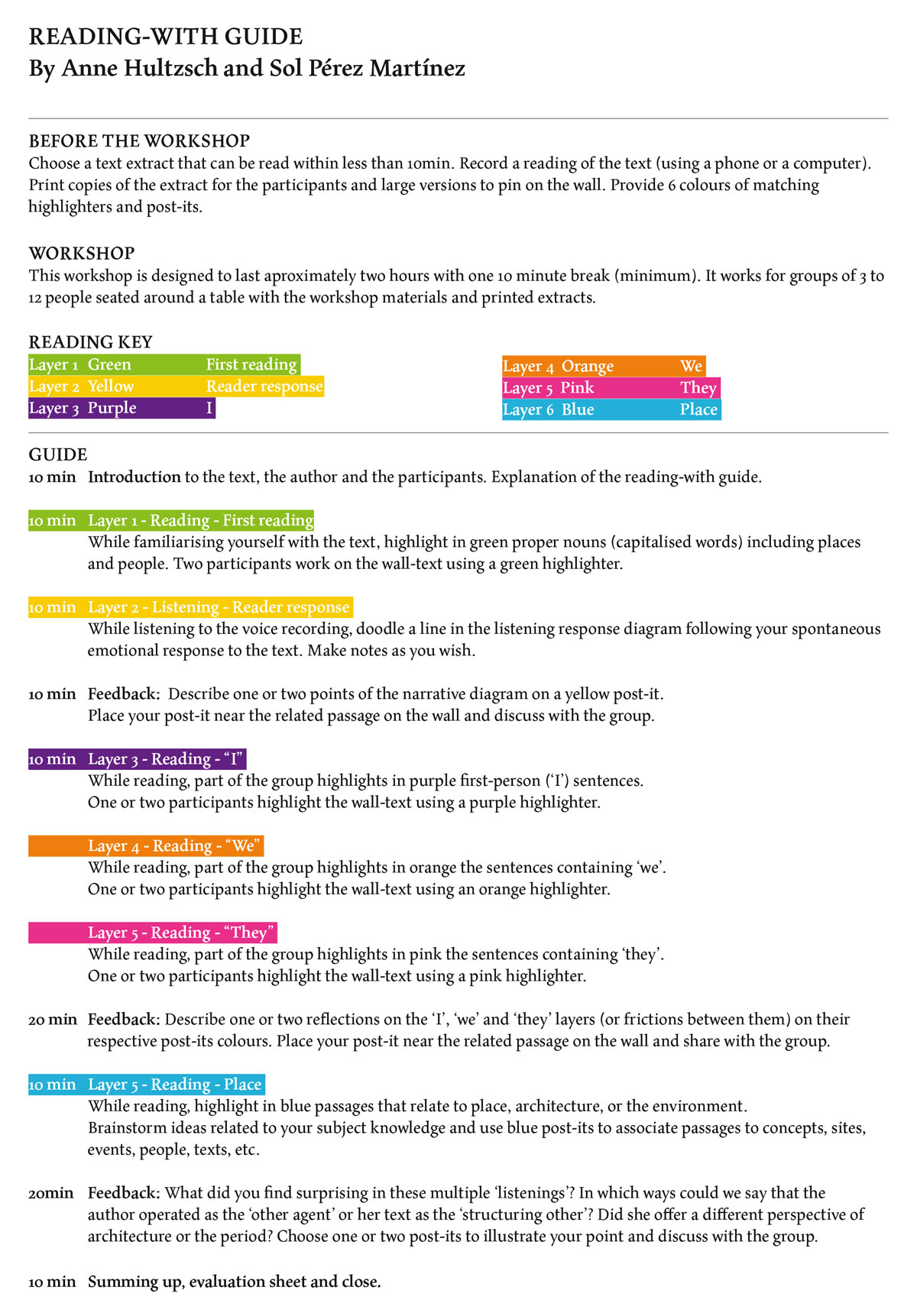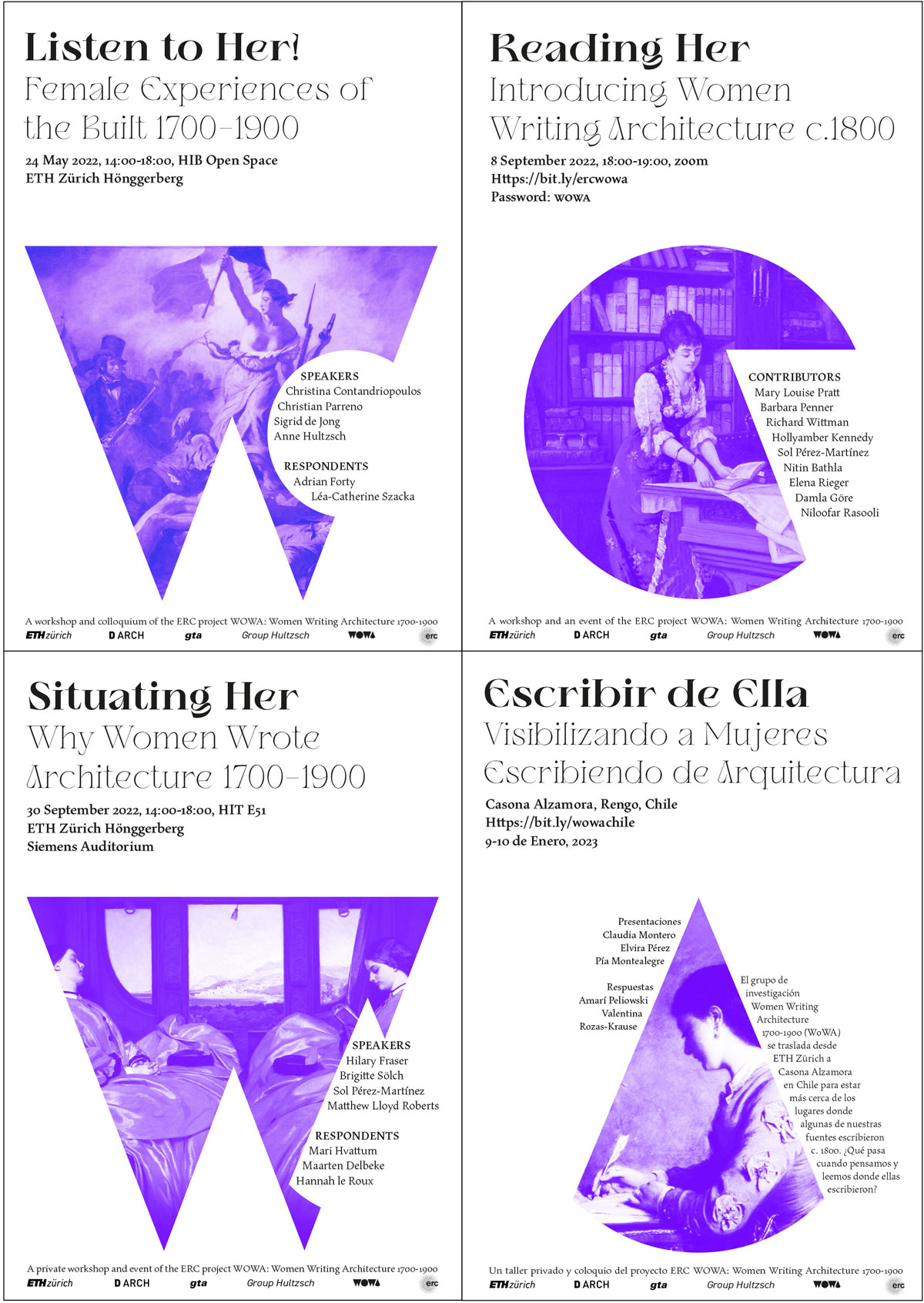Reading Women Writing Architecture
Who are the protagonists of the histories we write? In this position paper we argue that, as architectural historians, we cannot limit ourselves to an elite of architects, their official critics, and their patrons; we must strive to write inclusive histories of the built environment that are also based on the experience and agency of marginalised people. We are certain that those excluded from circles of power took part and determined how life was lived in the places we examine, yet our discipline has struggled in the past to acknowledge their participation and make them part of our histories. This article proposes ‘reading-with’ as a method to help unmask our academic biases, offering an alternative to canonical methods of reading and knowing. Developed as part of the ERC-funded project WoWA (Women Writing Architecture 1700–1900), reading-with helps us to make visible the architectural agency of women in Europe and South America during the 18th and 19th centuries by collectively analysing their writings using our Reading-with Guide.1
Reading-with is a feminist, immersive, and collaborative method, consisting of a scripted set of reading layers that enables participants to read both with each other and with marginalised authors, exploring sidelined or hidden experiences of the built environment. Developed through workshops with scholars and students, we designed reading-with to support researchers to look for marginalised voices beyond the canon and to un-learn approaches which reinforce the architect/critic as the dominant agent in the construction of the built environment. In this article, we share a guide to the method, describe its development through four workshops in Switzerland and Chile, and outline its origins that are based on Carol Gilligan’s ‘Listening Guide’ for interviews and oral testimonies (Gilligan 2015). We show that by transferring Gilligan’s oral history method to architectural history, we enrich our approaches to historical text analysis and empower researchers to make visible sources that are otherwise marginalised. While demonstrating a reading method, we also employ a specific writing mode, with distinct voices mingling as we write either jointly as ‘we’ (Anne Hultzsch and Sol Pérez Martínez) or individually, as ‘I’.
When I, Anne Hultzsch, set up WoWA, my intention was to broaden our approach to the protagonists we investigate in architectural histories. As a precondition for inclusivity, WoWA and this method redefine the ‘architectural agent’ to reclaim the concept of agency from the practice of disegno — design and drawing — to include power and influence over architectural cultures beyond professional elites (Hultzsch, in Hultzsch, Thomas, and Pérez Martínez 2023). Though I am not the first to point out the relevance of non-professional figures for architectural histories, I actively want to go beyond single case studies of extraordinary (and often othered) exceptions to show that, with new methods, we can place inclusivity at the centre of our field. WoWA builds on the premise that the female authors we examine gained agency by sharing their experiences and commentaries on cities, buildings, or landscapes, for a wide public to read. Reading-with gives credit to this agency and recognises that these other agents were read and heard during their time.
The Origins of the Listening Guide
While listening to women considering having an abortion during the 1970s, Gilligan, a feminist psychologist and educator, realised that the ‘psychological literature of that time’ was written from a point of view that did not help to make sense of the testimonies of these women(Gilligan 2015: 70). Her research revealed how the ‘voice’ of psychological theory ‘privileged autonomy over … relationship, reason over emotion’, mind over body, and disregarded women’s experiences, ‘as if human were synonymous with masculine’ (Gilligan 2015: 69). Gilligan published her findings in an article titled ‘In a Different Voice’, advocating for the importance of carefully listening to other voices, including those of women, to construct inclusive representations of adulthood (Gilligan 1977). According to Gilligan, these alternative voices presented a relational, caring, and human approach to the world, which was distinct from others described in psychological literature and which she later called an ‘ethics of care’ (Hobby School of Public Affairs 2022). Over the following years, Gilligan’s work transformed human-related research by demonstrating that psychological theory had a masculine bias which reinforced a patriarchal view of the world, fuelling feminist scholarship in the humanities and beyond (Gilligan 1982).
Following her discovery of a ‘different voice’, Gilligan and a group of graduate students at Harvard School of Education developed a method to identify multiple voices and engage in what she called a practice of ‘radical listening’ (Gilligan and Eddy 2021: 141–42). To systematize the process of listening, they created the Listening Guide, with questions and prompts designed to both facilitate the analysis of different layers of a narrative and bring attention to those stories which were left partly said or silenced. Gilligan and her students proposed that by engaging in several focused ‘listenings’, the reader or listener was pushed to separate distinct layers of content and thus concentrate on a singular aspect of the text or audio, similar to repeatedly listening to the same song while paying attention to different instruments (Gilligan 2015).
The first Listening Guide had four stages. In the first stage, researchers were encouraged to listen to the plot of the stories told and to be aware of their own response to the reading by annotating it with emotions or questions, and to ‘then consider how our thoughts and feelings may affect our understanding, our interpretation’ of the narration (Brown and Gilligan 1992: 27). The aim of this ‘reader response’ stage was for the researcher to understand the preconceptions they bring to the analysis and representation of a narrative. Thus, the guide starts by observing the position of the researcher as listener or reader and their relation to the narrator, a key aspect of a feminist and relational method. In the second stage, called ‘listening to the self’, the researcher pays attention to how the narrator speaks about themselves in sentences starting with ‘I’ or when the narrator shares their perspective. The third stage looks at alternative voices present in the narration, considering undertones or silences. The final stage arrives at an analytic synthesis which is later shared and discussed with the narrator.
Since the creation of that first Listening Guide, the method has been expanded and used in social sciences, action research, history, gender studies, and literary analysis, not only for interviews but also for first-person written texts. One of the adaptations was developed by two of Gilligan’s former graduate students, Natasha Mauthner and Andrea Doucet, who renamed it the ‘Voice-Centred Relational Method’ to emphasise its goal (Mauthner and Doucet 1998). Mauthner and Doucet further systematised the last stages of their Listening Guide to highlight the narrator’s relation to other people and the context. According to Mauthner and Doucet, the third layer pays attention to the ‘we’ in the narration, ‘reading for social networks … and intimate relations … informed by feminist theoretical critiques of individualist conceptions of agency and their replacement with relational concepts of subjects’. The fourth layer listens to the social, economic, and political context to focus ‘on structured power relations and dominant ideologies that frame narratives’ (Doucet and Mauthner 2008: 407, 406). This adaptation brings the method closer to the location of the narration, making it a productive method for the analysis of architectural histories from a feminist standpoint.
Transferring the Listening Guide to Architectural History
Before our collaboration with WoWA began, I, Sol Pérez Martínez, worked with the Listening Guide as part of my doctoral research in architectural history and education, for which I conducted 26 in-depth oral history interviews in Britain and Chile. When later analysing them, I adapted the Listening Guide to pay attention to the relationships embedded within their narratives while also separating the analysis of the voice of the interviewee from the interviewer (Perez Martinez 2022b).
Since the 1970s, the use of oral history for architectural research has been explored by scholars such as Monica Pidgeon and, most recently, Naomi Stead, Janina Gosseye, and Deborah Van der Plaat in their book Speaking of Buildings: Oral History in Architectural Research (2019; Sandino 2010; ‘Pidgeon Digital’ n.d.). A similar tradition of oral history in feminist research goes back to the edited collection called Women’s Words, by Sherna Berger Gluck and Daphne Patai (1991). However, though the methodology and its application have been covered in architecture and feminist research, what has remained less clear is the process of doing a feminist analysis of written texts that emerge from oral histories and other narratives generally (Maynard 2004: 131).
To listen carefully to what the interviewees said and to listen separately to both their voices and mine, I used Doucet and Mauthner’s version of the Listening Guide as a starting point (Mauthner and Doucet 1998). I adapted their approach to examine the interviews, paying attention to the narratives of the participants and their relationships to other human and non-human actors (Perez Martinez 2022b). Doucet and Mauthner’s method was powerful in that it encouraged a constant process of reflexivity that made visible the voice of the researcher in response to — and separate from — the voice of the participants. I complemented the Listening Guide with a diagram that helped trace the reader’s response when working with multiple long transcripts and to track my personal response when analysing the interviews (Figures 1, 2). This new version of the Listening Guide allowed me to leave behind any ‘evidential’ interpretation of the interviews in which the participants’ narratives were sources that supported my argument (Abrams 2010: 15). Instead, I shifted to a situated and relational approach in which I listened carefully to both what the interviewees told me and how our relationship shaped that narrative, in an interpretation of the texts that was at the same time theoretical, evidential, and attentive to the interviewee’s process of reminiscence (Perez Martinez 2022b). Most importantly, by transferring this method to architectural history and to written texts, I realised its potential to bring our attention to the ‘baggage’ we researchers carry and to hear stories that sometimes are not explicitly told. The Listening Guide is innovative because it interrupts our normal reading speed, which delays conventional analytical methods and thus promotes an approach which is attentive and grounded in the narrative.
Listening response diagram, illustrating Pérez Martínez’s listening response to part of an interview. The y axis corresponds to the emotional response from low to high, and the x axis corresponds to the narrative time from start (left) to finish (right). Illustration from Pérez Martínez (2022b: 211).
Participant using the listening response diagram during a reading-with workshop in Chile called Writing Her/Escribir de Ella. Still from the video recording (WoWA 2023b).
Transferring the Listening Guide to WoWA
As part of WoWA, we both saw the potential of this method for reading our sources, and together we developed the Reading-with Guide: an experimental workshop methodology, performing Gilligan’s radical listening as a collective exercise with historical texts focused on spaces and places. After we selected historical first-person narratives by women, each layer of instructions was colour-coded to make them visibly different. We asked participants to use these colours to intervene on large-scale prints of the texts, making the analysis active, visual, and collaborative (Figure 3, 4) (WoWA 2023b). We guided them to focus first on a reading to get to know the text (layer 1), then to recognise their own emotional response (layer 2), followed by the identification of the different voices in the text, including ‘I’, ‘we’, and ‘they’ (layers 3, 4, 5). In the last reading (layer 6), we invited participants to pay attention to place, including architectures, cities, and landscapes, foregrounding architectural history as part of the final analytical synthesis. We called this new method ‘reading-with’ to highlight its collective and immersive processes and establish a connection with feminist scholarship, such as Donna Haraway’s conception of ‘thinking-with’ as a relational and situated process (Haraway 2016) (Figure 5).2
As other feminists in architecture have done, we firmly situate architecture in an expanded field that listens as much to the designer as to the user of spaces. Our methodological experiment joins other recent feminist collaborations that enrich architectural history (including Steiner, Riesto, and Bendsen 2023; Burns and Brown 2020; Frey and Perotti 2015; Frichot, Gabrielsson, and Runting 2017; Lange and Pérez-Moreno 2020; Moisset et al. 2015; Siddiqi and Lee 2019; Thomas and Appercé 2021). However, the specific goal of both the Reading-with Guide and WoWA is to apply recent critical feminist approaches to pre-1900 sources, protagonists, and contexts of architecture.
Using the Reading-with Guide
During 2022 and 2023, we invited early career and senior researchers to read with us a range of women authors, including Mary Wollstonecraft, Frances Calderón de la Barca, and Martina Barros Borgoño, using our reading-with method in four events — Listen to Her!, Reading Her, Situating Her, and Writing Her/Escribir de Ella (Figure 6). We simultaneously applied the method in a teaching setting, reading-with master students at ETH Zurich as part of the 2023 course called Parity in History?, adding digital and visual tools to facilitate collaboration. In these small-group settings, we followed the precisely timed script of the six reading-with layers, executing the specific tasks outlined above. By making layer 2 a listening layer, during which participants do not read but instead listen to a recorded voice and fill in the response diagram, we reinforced the original method’s aim of acknowledging our individual, personal, and spontaneous emotional reactions, which are often ignored or actively erased in academic reading. For example, when reading colonial accounts by authors such as Maria Graham or Frances Calderón de la Barca, we became aware that this layer in particular allowed us to acknowledge sensations evoked by the text’s othering of peoples and places, prompting postcolonial reflections. Tracking our reading response in this way highlighted the readers’ personal relationship to a text and an author, enabling us to employ these observations to drive our scholarly analysis.
During these events, we observed how the method allowed us to open new discursive spaces within the text as well as within our scholarship. By performing these reading layers in a clearly defined spatial and timed setting, which alternated with discussion periods, researchers began to read with each other as much as with the author. Also, by shifting between reading printed media and listening to the oral expression of a text, we explored what literary scholar Walter Ong calls ‘secondary orality’, a focused, communal, and consciously present approach to spoken texts (Ong and Hartley 2012: 134). Rather than building concise arguments, we brainstormed and connected fragments by limiting notetaking to handwriting on small pieces of paper, which created visible networks of ideas and prevented the smoothing out of complexities or the construction of a single narrative.
The main limitation of this method is time. Reading in layers is time consuming, and reading collectively even more so. Thus, this method cannot be used thoroughly for long texts, which pushes facilitators to choose fragments of texts rather than books. However, this limitation is also part of its potential, since it prevents the illusion of comprehensiveness or objectivity in reading first-person accounts and offers a different starting point for in-depth research. Reading-with as a method does not give answers but instead helps to calibrate the researcher’s reading of marginalised voices by making us aware of biases when reading the authors and their context; it also expands our notion of what an ‘architectural text’ might be.
We developed these workshops and this method to sharpen our own modes of reading and to collectively initiate new insights into our sources, closely examining texts that usually fall outside of our disciplinary canons. As we read women who had nothing obvious to do with architecture as a profession or design practice, we keep asking, what are we looking for in these texts? This is not about forgetting what is commonly called the canon, nor is it about flavouring or window-dressing it with rare sources. It is about ‘differencing’ the canon, to use Griselda Pollock’s words, by means of an ‘active re-reading’ of its ‘always present … structuring other’ (Pollock 1999: 8; Hultzsch 2022c). With the Reading-with Guide, we apply the concept of ‘active re-reading’ literally by reading-with both colleagues and the historical author in a collective setting in order to expand and ‘difference’ spatial histories. In WoWA, we use reading-with to inform and reflect on our work towards inclusive architectural histories.
Politics of Reading-with
We argue that histories of the built environment need to expand their evidence base to play an active part in a world of planetary challenges, countering increasing polarity and inequality (Pratt 2022). Historians cannot continue to reinforce engrained exclusions and privileges in our historiographical practice while hoping the future will be different. Reading-with authors who have been marginalized is a political act in the sense that it challenges historians of the built environment to engage with voices and positions that have been side-lined.3 Such an engagement will help us uncover the agency of those marginalized voices in an effort to contribute and produce knowledge for a more equitable world. The canon, and most textbooks used in history of architecture courses, might not refer to women in this period, but with WoWA we set out to find many of those identifying as women between 1700 and 1900 who had something to say about their environments. Reading-with helps us to actively re-read their writings to hear the nuances that expand, contradict, or alter what we know already about architecture and its discourses in the period. Reading in layers supports an intersectional listening to marginalised voices, considering simultaneously issues of race, class, gender, sexuality, or ability, while taking into account our own situations as researchers.
By means of reading-with, we have found and continue to discover women driving discourses and wielding public influence on architectural culture in the 18th and 19th centuries in WoWA’s geographies of South America and Europe (Hultzsch 2021; 2022a; 2022b; 2022c; 2023a; 2023b; Pérez Martínez 2022a; 2022c). The so-called separate spheres of private and public, home and street, were not quite as separate or binary as is often argued, and there is clear reason to listen to what women and other marginalised groups had to say on architecture. During the workshops, participants confirmed that they will use reading-with in their own work, as they considered it a ‘very simple and useful method to use in several contexts’ and ‘a very valuable discovery’ to look ‘at a text from different angles’ (WoWA 2023a).
We acknowledge that writing and publishing did imply privilege in the period we are considering, which means that there are limits to the inclusivity of this method, yet these practices were far more open than those of designing and building — as is probably still the case today. I, Anne Hultzsch, have set up WoWA convinced that, if we read more women or other marginalised groups as agents, we will read more eyewitnesses, more dwellers, more users of spaces; we will also read more critics, experts, scholars, and thinkers. If we start to expand our corpus as historians by including these ‘other voices’, we will by necessity write histories differently.
We believe it is our job as historians to find appropriate methods to learn to listen and to read a broad range of perspectives and understand what they tell us about their environments, about buildings, landscapes, cities, and other spaces. In addition to making visible the women and their writings which we deem relevant to architectural histories, we invite others to apply this reading method to read with a diverse range of authors as well as with each other.
Notes
- WoWA is short for Women Writing Architecture 1700–1900: Female Experiences of the Built, a project funded by Horizon 2020 and based at ETH Zurich from 2021 to 2026. See https://wowa.arch.ethz.ch. [^]
- The name of this method was developed in a meeting with Elena Rieger, doctoral candidate and member of WoWA. [^]
- We are grateful to Olga Touloumi for making us think about this during the editorial process. [^]
Authors’ Note
This piece was co-written by the authors.
We would like to specially thank Olga Touloumi for her enriching editorial feedback as well as the students in the course Parity in History? at ETH Zurich in autumn 2022 and the participants of the WoWA Workshops 2022–23: Adrian Forty, Amarí Peliowski, Brigitte Sölch, Camila Medina Novoa, Christian Parreno, Christina Contandriopoulos, Claudia Montero, Damaris Landeros, Damla Göre, Elvira Perez, Fernanda Claro, Hannah Le Roux, Helen Thomas, Hilary Fraser, Hollyamber Kennedy, Léa-Catherine Szacka, Liliana de Simone, Maarten Delbeke, Mari Hvattum, Matthew Lloyd Roberts, Natalia Gándara, Nikolaos Magouliotis, Niloofar Rasooli, Nitin Bathla, Pía Montealegre, Sigrid de Jong, Tatiana Carbonell Guillon, Valentina Rozas-Krause, Verónica Ramirez, and Yolanda Muñoz.
This article is part of a project that received funding from the European Research Council (ERC) under the European Union’s Horizon 2020 research and innovation programme (Grant agreement No. 949525).
Competing Interests
The authors have no competing interests to declare.
References
Abrams, L. 2010. Oral History Theory. London: Routledge. DOI: http://doi.org/10.4324/9780203849033
Brown, LM, and Gilligan, C. 1992. The Harmonics of Relationship. In: Meeting at the Crossroads: Women’s Psychology and Girls’ Development, 18–41. Cambridge, MA: Harvard University Press. https://hup.degruyter.com/view/book/9780674731837/10.4159/harvard.9780674731837.c3.xml. DOI: http://doi.org/10.4159/harvard.9780674731837.c3
Burns, K, and Brown, L. 2020. Telling Transnational Histories of Women in Architecture, 1960–2015. Architectural Histories, 8(1). DOI: http://doi.org/10.5334/ah.403
Doucet, A, and Mauthner, NS. 2008. What Can Be Known and How? Narrated Subjects and the Listening Guide. Qualitative Research, 8(3): 399–409. DOI: http://doi.org/10.1177/1468794106093636
Frey, K, Perotti, E, et al. 2015. Theoretikerinnen Des Städtebaus: Texte Und Projekte Für Die Stadt. Berlin: Dietrich Reimer.
Frichot, H, Gabrielsson, C, and Runting, H (eds.). 2017. Architecture and Feminisms: Ecologies, Economies, Technologies. London: Routledge. DOI: http://doi.org/10.4324/9780203729717
Gilligan, C. 1977. In a Different Voice: Women’s Conceptions of Self and of Morality. Harvard Educational Review, 47: 481–517. DOI: http://doi.org/10.17763/haer.47.4.g6167429416hg5l0
Gilligan, C. 1982. In a Different Voice: Psychological Theory and Women’s Development. Cambridge, MA: Harvard University Press.
Gilligan, C. 2015. The Listening Guide Method of Psychological Inquiry. Qualitative Psychology, 2(1): 69–77. DOI: http://doi.org/10.1037/qup0000023
Gilligan, C, and Eddy, J. 2021. The Listening Guide: Replacing Judgment with Curiosity. Qualitative Psychology, 8(2): 141. DOI: http://doi.org/10.1037/qup0000213
Gluck, SB, and Patai, D. 1991. Women’s Words: The Feminist Practice of Oral History. Routledge.
Haraway, DJ. 2016. Staying with the Trouble: Making Kin in the Chthulucene. Durham, NC: Duke University Press. DOI: http://doi.org/10.1215/9780822373780
Hobby School of Public Affairs. 2022. Carol Gilligan, ‘In a Different Voice: Why Does Nobody Talk About the Abortion Decisions?’ Uploaded Jan 31. YouTube video, 1:38:41. https://youtu.be/Lvz6FhWOA4A.
Hultzsch, A. 2021. The Female Eyewitness: Gendering Histories of Architecture. Dean’s Talk, Sept. 11, ETH Zürich, Video Portal, Speakers. 1:19:02. https://video.ethz.ch/speakers/d-arch/2021/autumn/hs21/a6b0df90–4be5–4d80–8eae-6603176667e6.html.
Hultzsch, A. 2022a. ‘Architecture, or Whatever Title We May Give to the Manner of Building Here’: Maria Graham in India and Chile, 1812 and 1824. Presented at the workshop Listen to Her! Female Experiences of the Built 1700–1900, ETH Zurich, May 24.
Hultzsch, A. 2022b. Why There Hasn’t Been a Ladies Magazine for Architecture: Retracing Jane Webb Loudon. Presented at the EAHN 2022 Conference, Madrid, June 18.
Hultzsch, A. 2022c. Other Practices: Gendering Histories of Architecture/Otras Prácticas: Historias de La Arquitectura Con Perspectiva de Género. ZARCH 18 (September): 30–41. DOI: http://doi.org/10.26754/ojs_zarch/zarch.2022186968
Hultzsch, A. 2023a. The City ‘En Miniature’: Situating Sophie von La Roche in the Window. Journal 18, 15 Cities (Spring). https://www.journal18.org/6782.
Hultzsch, A. 2023b. ‘Feminist Bricks’: Women Writing Paris around 1789. Lecture, Edinburgh School of Architecture and Landscape Architecture, March 14.
Hultzsch, A, Thomas, H, and Pérez Martínez, S. 2023. Women Writing Architecture. Presented at the The Bartlett Gender and Urban Equalities Symposium. Uploaded to Youtube by The Bartlett, UCL Faculty of the Built Environment, March 8. https://youtu.be/e7VYPP-MWE0.
Lange, T, and Pérez-Moreno, LC. 2020. Architectural Historiography and Fourth Wave Feminism. Architectural Histories 8 (1). DOI: http://doi.org/10.5334/ah.563
Mauthner, N, and Doucet, A. 1998. Reflections on a Voice-Centred Relational Method: Analysing Maternal and Domestic Voices. In: Ribbens, J, and Edwards, R (eds.), Feminist Dilemmas in Qualitative Research, 119–46. London: SAGE Publications. DOI: http://doi.org/10.4135/9781849209137.n8
Maynard, M. 2004. Feminist Issues in Data Analysis. In: Hardy, M, and Bryman, A (eds.), Handbook of Data Analysis, 131–45. London: SAGE Publications. DOI: http://doi.org/10.4135/9781848608184.n6
Moisset, I, Ojeda, G, et al. 2015. Un Día Una Arquitecta — Revisar La Historia. un día | una arquitecta (blog). June 8. https://undiaunaarquitecta.wordpress.com/publicaciones/revisar-la-historia/.
Ong, WJ, and Hartley, J. 2012. Orality and Literacy: 30th Anniversary Edition. 3rd ed. London: Routledge. DOI: http://doi.org/10.4324/9780203103258
Pérez Martínez, S. 2022a. Hosting Marianne North. Encounters between Women, Places and Cultures in Chile, 1884. Presented at the symposium Situating Her: Why Women Wrote Architecture 1700–1900, ETH Zurich, September 30.
Perez Martinez, S. 2022b. Learn Where You Stand: Lessons for Civic Engagement in Architecture and the Built Environment from the Urban Studies Centres Network and Their Situated Pedagogies in Britain 1968–1988. Unpublished diss. (PhD), University College London. https://discovery.ucl.ac.uk/id/eprint/10142987/.
Pérez Martínez, S. 2022c. Mujeres haciendo espacio en Chile 1800 – 1900: Santiago y la poeta popular Rosa Araneda. Revista Historia y Patrimonio, 2(2): 1–30. DOI: http://doi.org/10.5354/2810-6245.2023.70518
Pidgeon Digital. Accessed 24 August 2023. https://www.pidgeondigital.com/.
Pollock, G. 1999. Differencing the Canon: Feminist Desire and the Writing of Art’s Histories. London: Psychology Press.
Pratt, ML. 2022. Planetary Longings. Durham, NC: Duke University Press. DOI: http://doi.org/10.1215/9781478022909
Sandino, L. 2010. Speaking of Memory … AA Files, 61: 116–17.
Siddiqi, AI, and Lee, R. 2019. On Margins: Feminist Architectural Histories of Migration. ABE Journal: Architecture beyond Europe, 16 (December). DOI: http://doi.org/10.4000/abe.7126
Stead, N, Gosseye, J, and van der Plaat, D (eds.). 2019. Speaking of Buildings: Oral History in Architectural Research. New York: Princeton Architectural Press.
Steiner, H, Riesto, S, and Rosenberg Bendsen, J. 2023. Untold Stories: Women, Gender, and Architecture in Denmark 1930–1980. Copenhagen: Strandberg Publishing.
Thomas, H, and Appercé, E. 2021. Women Writing Architecture (website, launched in June). https://womenwritingarchitecture.org/.
WoWA [Women Writing Architecture 1700–1900]. 2023a. WoWA 2022–2023 Workshop Evaluations.
WoWA, dir. 2023b. Writing Her: Making Visible Women Writing Architecture c.1800 (Escribir de Ella). Workshop and symposium at Casona Alzamora, Rengo, Chile, 10 January 2023. Uploaded on February 27. Youtube video, 1:47. https://youtu.be/_VxVHZwinjQ.
